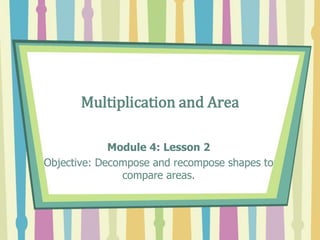Report
Share

Recommended
Recommended
More Related Content
What's hot
What's hot (18)
2nd 9 weeks review independent review unit 2 and unit 3

2nd 9 weeks review independent review unit 2 and unit 3
subtraction of whole numbers with continuous or non continuous zeros with reg...

subtraction of whole numbers with continuous or non continuous zeros with reg...
Viewers also liked
Viewers also liked (6)
Similar to Module 4 Lesson 2
Similar to Module 4 Lesson 2 (20)
More from NRWEG3
More from NRWEG3 (20)
Recently uploaded
Mehran University Newsletter is a Quarterly Publication from Public Relations OfficeMehran University Newsletter Vol-X, Issue-I, 2024

Mehran University Newsletter Vol-X, Issue-I, 2024Mehran University of Engineering & Technology, Jamshoro
https://app.box.com/s/x7vf0j7xaxl2hlczxm3ny497y4yto33i80 ĐỀ THI THỬ TUYỂN SINH TIẾNG ANH VÀO 10 SỞ GD – ĐT THÀNH PHỐ HỒ CHÍ MINH NĂ...

80 ĐỀ THI THỬ TUYỂN SINH TIẾNG ANH VÀO 10 SỞ GD – ĐT THÀNH PHỐ HỒ CHÍ MINH NĂ...Nguyen Thanh Tu Collection
Recently uploaded (20)
ICT Role in 21st Century Education & its Challenges.pptx

ICT Role in 21st Century Education & its Challenges.pptx
ICT role in 21st century education and it's challenges.

ICT role in 21st century education and it's challenges.
Micro-Scholarship, What it is, How can it help me.pdf

Micro-Scholarship, What it is, How can it help me.pdf
Basic Civil Engineering first year Notes- Chapter 4 Building.pptx

Basic Civil Engineering first year Notes- Chapter 4 Building.pptx
HMCS Max Bernays Pre-Deployment Brief (May 2024).pptx

HMCS Max Bernays Pre-Deployment Brief (May 2024).pptx
Sensory_Experience_and_Emotional_Resonance_in_Gabriel_Okaras_The_Piano_and_Th...

Sensory_Experience_and_Emotional_Resonance_in_Gabriel_Okaras_The_Piano_and_Th...
Kodo Millet PPT made by Ghanshyam bairwa college of Agriculture kumher bhara...

Kodo Millet PPT made by Ghanshyam bairwa college of Agriculture kumher bhara...
80 ĐỀ THI THỬ TUYỂN SINH TIẾNG ANH VÀO 10 SỞ GD – ĐT THÀNH PHỐ HỒ CHÍ MINH NĂ...

80 ĐỀ THI THỬ TUYỂN SINH TIẾNG ANH VÀO 10 SỞ GD – ĐT THÀNH PHỐ HỒ CHÍ MINH NĂ...
Module 4 Lesson 2
- 1. Multiplication and Area Module 4: Lesson 2 Objective: Decompose and recompose shapes to compare areas.
- 2. Group Counting (4 minutes) Count forward and backward, occasionally changing the direction of the count. • Sixes to 60 • Sevens to 70 • Eights to 80 • Nines to 90
- 3. Multiply by 4 (7 Minutes) • Write 7 × 4.) Let’s skip-count up by fours. (Count with fingers to 7 as students count.) • What is 7 × 4? • Let’s see how we can skip-count down to find the answer, too. (Show 10 fingers.) Start at 10 fours, 40. (Count down with your fingers as students say numbers.) • Continue with the following possible sequence: 9 × 4, 6 × 4, and 8 × 4.
- 4. Multiply by 4 Pattern Sheet • Let’s practice multiplying by 4. Be sure to work left to right across the page.
- 5. Application Problem (5 Minutes) • Wilma and Freddie use patterns blocks to make shapes as shown. Freddie says his shape is bigger than Wilma’s because it’s longer than hers. Is he right? Explain your answer.
- 7. Concept Development (34 minutes) Students begin with Paper Strip 1. • Measure your strip. How tall is it? • Start at the edge of your strip and use your ruler to mark inches along the top. Do the same along the bottom. Use your ruler to connect the marks at the top to the matching marks at the bottom. • How many units make up your strip? • What shape are they? • What is the area of the paper strip in square units?
- 8. Concept Development (34 minutes) • Did the number of squares change? • Talk to a partner. What changed about the way we talked about the area of the paper strip? • Cut your paper strip along the lines you drew. Now rearrange all 12 squares into 2 equal rows. Remember, the squares have to touch but can’t overlap. • Draw your rectangle in the chart for Problem 1. What is the area of the rectangle?
- 9. Concept Development • Record the area. You can record it by writing 12 square inches, or you can write 12 sq in. • Rearrange all 12 squares into 3 equal rows to make a new rectangle. Draw it in the chart and record the area. At my signal, whisper the area of your rectangle to a partner. (Signal.) • Rearrange all 12 squares into 4 equal rows to make a new rectangle. Draw it in the chart and record the area. At my signal, whisper the area of your rectangle to a partner. (Signal.)
- 10. Concept Development • How is it possible that these three different rectangles and our paper strip all have the same area? • Repeat the process with Paper Strip 2 (1 cm × 12 cm).
- 11. Problem Set (10 minutes) You have 10 minutes to complete the problem set pages. Debrief (10 minutes) Let’s review your solutions for the problem set.
- 12. Exit Ticket (3 minutes) This is where you are going to show us that you understand what we learned today! We will learn if you are ready for the next lesson!
- 13. Homework Lesson 2 Homework Worksheet Is Due Tomorrow!